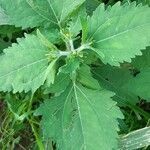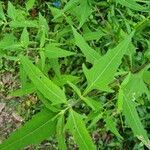Annual erect herbs or subshrubs (0.15–) 0.4–0.8 (–1.5) m high, often much branched with reddish stems. Leaves with winged petiole 5–60 mm long; lamina deltoid, broadly lanceolate or lanceolate, (25–) 30–120 (–150) mm long, (10–) 15–90 (–100) mm wide, acute to truncate at base, toothed, with teeth acute to rounded and largest teeth at base, rarely entire, attenuate, scaberulous on both surfaces, sometimes sparsely glandular. Capitula in loose corymbose panicles, 6–10 mm diam. excluding spreading involucral bracts; involucral bracts usually clavate or narrowly spathulate, 5–10 (–15) mm long, 2–3 times length of florets, densely stalked-glandular; outer paleae green to purplish, coarsely stalked-glandular, enfolding the outer achenes; inner paleae obovate, 3 mm long, membranous, become whitish, flattened. Florets yellow. Ray florets 3–5; ligule c. 1 mm long. Achenes slightly 3-or 4-angled, usually curved, 2–3 mm long, dark brown to purplish black.
Annuals. Stems erect, simple or dichotomously branched, branches opposite, obtusely angulate, 30-75(-100) cm tall, ± crisp pubescent to densely pubescent, especially in upper part. Leaves ovate-triangular, ovate, or oblong-ovate, finely and appressed pilose, especially abaxially, sometimes with sparse small glands and hairs, base cuneate or rounded to subcordate, margin largely and usually unequally toothed to sinuate-dentate, sometimes resembling reduced leaves of sunflower, apex acute or acuminate. Capitula small, ca. 5 mm wide; outer phyllaries with dense stipitate-glandular hairs, oblong-obovate or linear-spatulate, considerably longer than inner, sometimes broader and with small number of glands or shorter. Achenes dark gray or dull black, obpyramidal, sometimes with sparse, more lucid, laevigate irregular tubercles, ca. 3 × 1.2 mm, with white annular groove at apex, marginal achenes slightly curved. Fl. Apr-Sep, fr. Jun-Nov. 2n = 30, 60.
Annual herb 20–120 cm high; stems often red or purplish, pilose.. Leaves ovate to triangular-hastate, 5–18 cm long, 3–11 cm wide, base cuneate to truncate, margins irregularly dentate or serrate, apex obtuse or acute, short-pubescent and often slightly scabridulous on both surfaces and glandular beneath; 3-veined from near base; petiole 1–5 cm long, often slightly winged.. Capitula in lax leafy dichotomous panicles; involucre 5–7 mm long, green; outer phyllaries linear-spatulate, 5–15 mm long; inner phyllaries 5 mm long, all with stalked glands; paleae also often glandular.. Ray florets usually 5, yellow, ray 1.3–1.5 mm long; disc florets ± 12, yellow, ± 1 mm long, glandular near base.. Achenes dark brown or blackish, curved, 3–4 mm long, glandular-pubescent; pappus absent.. Fig. 169 (page 777).
Annual herb 20-120 cm high; stems often red or purplish, pilose. Leaves ovate to triangular-hastate, 5-18 cm long, 3-11 cm wide, base cuneate to truncate, margins irregularly dentate or serrate, apex obtuse or acute, short-pubescent and often slightly scabridulous on both surfaces and glandular beneath; 3-veined from near base; petiole 1-5 cm long, often slightly winged. Capitula in lax leafy dichotomous panicles; involucre 5-7 mm long, green; outer phyllaries linear-spatulate, 5-15 mm long; inner phyllaries 5 mm long, all with stalked glands; paleae also often glandular. Ray florets usually 5, yellow, ray 1.3-1.5 mm long; disc florets ±12, yellow, ±1 mm long, glandular near base. Achenes dark brown or blackish, curved, 3-4 mm long, glandular-pubescent; pappus absent.
Annual 3–10 dm, strigose to hirsutulous; lvs resinous-dotted beneath, ovate or deltoid, coarsely toothed, 4–12 × 2–7 cm, the petiole to half as long, with slender base and upwardly expanding wing-margins; heads rather numerous in small cymose clusters ending the branches; disk under 1 cm wide; invol very conspicuously stipitate-glandular, the loose outer bracts 5–15 mm; rays short and inconspicuous, yellowish or dirty white; achenes 3–3.5 mm; 2n=30. Waste places; native of e. Asia, sparingly intr. in our range. Summer.
Annual herb, up to 1 m high; stems pubescent. Leaves petiolate or subsessile, narrowly to broadly ovate, base broadly cuneate to truncate, apex acute, margins coarsely and irregularly toothed. Capitula many in lax, leafy panicles; Involucral bracts 5, linear-spathu-late, with spreading gland-tipped hairs. Ray florets inconspicuous, yellow. Disc florets yellow. Pappus absent. Cypselae narrowly obovate, 4-angled, curved, apex truncate.
Annual herb, up to 1 m high. Stems and leaves pubescent. Leaves petiolate or subsessile, narrowly to broadly ovate, sometimes bilobed towards base, margins coarsely and irregularly toothed. Involucral bracts linear-spathu-late, with spreading gland-tipped hairs. Flowers yellow; January to June and in October.
A herb. It often has many branches. It grows about 1 m tall. The leaves have winged leaf stalks about 0.5-6 cm long. The leaf blade is D shaped or sword shaped and 3-12 cm long by 1.5-9 cm wide. It narrows into the leaf stalk at the base. The flower head is loose and 0.6-1 cm across. The flowers are yellow.
Minute yellow ray-and disk-florets in heads 1/2 in. across, including the spreading outer involucre
An erect branched annual glandular herb about 3 ft. high
A weed.






